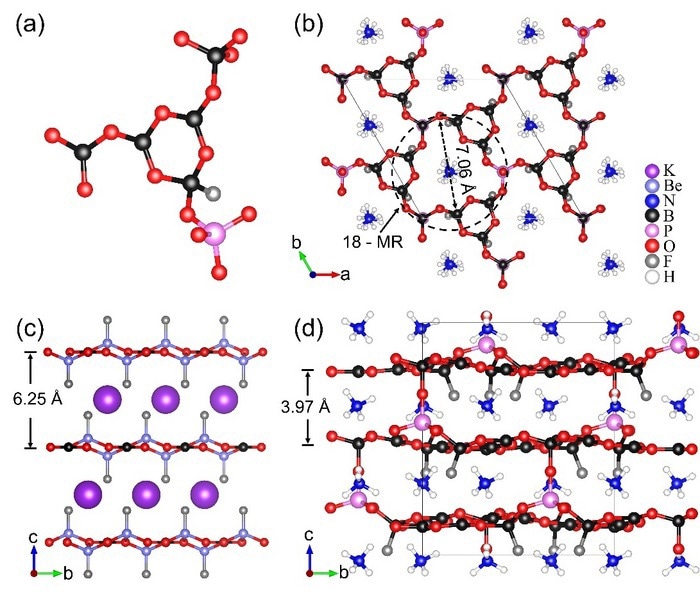Professors Fangfang Zhang (Xinjiang Technical Institute of Physics and Chemistry, Chinese Academy of Sciences) and Shilie Pan of the Chinese Academy of Sciences Xinjiang Technical Institute of Physics and Chemistry are the principal investigators of this project. The foundational components of all-solid-state lasers are deep-UV nonlinear optical (NLO) crystals.
 Figure 1. Crystal structures. (a) [B5PO14F] fundamental building block of (NH4)3B11PO19F3. (b) Two dimensional [B5PO10F]∞ layers with 18-membered rings in the ab-plane of (NH4)3B11PO19F3. (c) Layer structure of KBe2BO3F2 viewed along the a-axis. (d) Crystal structure of (NH4)3B11PO19F3 viewed along the a-axis. Image Credit: Science China Press
Figure 1. Crystal structures. (a) [B5PO14F] fundamental building block of (NH4)3B11PO19F3. (b) Two dimensional [B5PO10F]∞ layers with 18-membered rings in the ab-plane of (NH4)3B11PO19F3. (c) Layer structure of KBe2BO3F2 viewed along the a-axis. (d) Crystal structure of (NH4)3B11PO19F3 viewed along the a-axis. Image Credit: Science China Press
Typically, three fundamental requirements must be met for deep-UV NLO crystals, i.e., huge second harmonic generation (SHG) response (> 1 × KDP), short UV cutoff edge (λcutoff ≤ 200 nm), and appropriate birefringence (Δn: 0.05-0.10) to fulfill the requirements for deep-UV phase matching.
Until now, KBe2BO3F2 (KBBF) is the only real crystal that, using the SHG technique, can produce coherent light at wavelengths below 200 nm. It is critical to find new deep-UV NLO crystals with top-notch performance as laser technology advances.
To address the fundamental scientific conundrum of how to obtain the full performance balance of “large SHG response, deep-UV cut-off edge and suitable birefringence” in the design of deep-UV NLO materials, the fluorinated borate groups were suggested by Pan’s group as the best groups to use when creating deep-UV NLO materials.
Pan’s group recently expanded the “fluorination strategy” to the borophosphate system and synthesized a novel deep-UV NLO crystal (NH4)3B11PO19F3 (ABPF) with intricate anionic units.
ABPF has an exceptional fundamental building block [B5PO14F], and its anionic outline presents a KBBF-like layer [B5PO10F]∞. Strong B-O-P covalent connections are introduced, which reduces the interlayer distance, improves interlayer contact and prevents the layered growth pattern.
ABPF has exceptional optical features with a short cutoff edge (183 nm), a large SHG effect (1.2 × KDP), and an adequate birefringence (0.088 at 1064 nm) for deep-UV phase-matching.
What the anionic groups do, [BO3], [BO4], [BO3F], and [PO4] on the linear and nonlinear optical features of ABPF are uncovered by analysis of structures and first-principles calculations
The addition of π-conjugated units [BO3] benefits the significant SHG effect and enough birefringence, allowing ABPF to penetrate through the so-called “200 nm” wall.
Conversely, the addition of non-conjugated units [BO4], [BO3F], and [PO4] with significant HOMO-LUMO gaps aids in the elimination of the [BO3] units’ dangling bonds, resulting in deep-UV transparency.
As a result, the superior overall efficiency of ABPF is mostly due to its unique KBBF-like structure composed of π-conjugated and non-π-conjugated units. The current study exhibits the advancement of the “fluorination strategy” and the efficacy of employing several anionic groups in the investigation of high-performance deep-UV NLO crystals.
Journal Reference:
Cheng, B., et al. (2022) (NH4)3B11PO19F3: a deep-UV nonlinear optical crystal with unique [B5PO10F]∞ layers. National Science Review. doi.org/10.1093/nsr/nwac110.